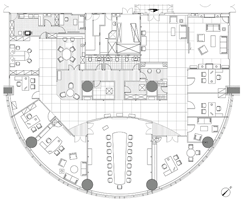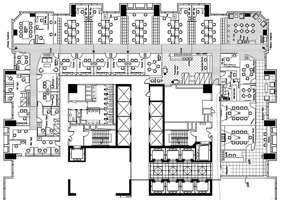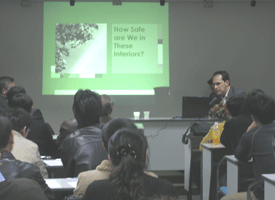| Topics:
How Safe are We in These Interiors?
What is “Green Design”
Indoor Air Quality
Common Hazardous Fit-Out Products
Current China Gov’t Regulations
“Huan Jing Biao Zhi”
Approved Testing Companies
Credits
什麽是“绿色设计”---室内空气质量
有害的装修产品
中国的政府法规---环保标志
有资质的检测公司/机构
感谢
What is “Green” Design?
The goal of green design is to create high-performance buildings. Often
called “sustainable design,” it evolved from a variety of concerns, experiences,
and needs…..
Energy efficiency gained importance during the 1970s oil crisis.
Recycling efforts in the U.S. in the 1970s onward became commonplace and
came to the attention of the building industry.
In the 1980s, the “sick building syndrome” concept emerged and concern
for worker health and productivity became an issue. The concern for toxic
material emissions also became an issue that needed to be addressed.
Projects in water-scarce areas began to focus on water conservation.
Early green designs usually focused on one issue at a time, mainly energy
efficiency or use of recycled materials.
Green building architects in the 1980s and 1990s began to realize that
the integration of all the factors mentioned here would produce the best
results and, in essence, a “high performance” building.
什麽是“绿色设计”
那些大量减少或消除建筑对环境和使用者带来的负面影响的设计和施工实践,主要有五个方面:
-室内空气质量
-资源和环境保护
-高效与可再生能源
-可持续发展的工地计划
-对水资源及水的有效利用的监督
7 R’s
Reduce减少
Reuse再利用
Remove拆除
Recover修复
Recycle循环使用
Repair修整
Respect尊重
Environmental Impact of Buildings*
65.2% of total U.S. electricity consumption
> 36% of total U.S. primary energy use
30% of total U.S. greenhouse gas emissions
136 million tons of construction and demolition waste in the U.S. (approx.
2.8 lbs/person/day)
12% of potable water in the U.S.
40% (3 billion tons annually) of raw materials use globally
* Commercial and residential
建筑对环境的影响(根据美国商业和住宅建筑的统计)
占有全美62.5%的电力消耗
大于36%的全美主要能源用量
占有全美30%绿色房屋气体排放量
1.36亿吨建造和拆迁垃圾
占有全美12%饮用水
40%全球原材料用量(每年30亿吨)
Benefits of Green Building
Environmental benefits
Reduce the impacts of natural resource consumption
Economic benefits
Improve the bottom line
Health and safety benefits
Enhance occupant comfort and health
Community benefits
Minimize strain on local infrastructures and improve quality of life
绿色建筑的好处
环境方面---减少自然资源消耗造成的影响
经济方面---提升底线
健康和安全方面---提升使用者的舒适度和健康度
社区方面---减轻当地社会结构的压力及提升生活品质
What Tenants want
BOMA/ULI survey: 1800 tenants in 126 metro areas in US
95% Temperature
94% Indoor Air Quality
Majority of Complaints: Indoor Environment Quality 77%
使用者的需求:
通过对全美126个城市区域内的1800名使用者的调查显示:
95%的人提到适宜的室内温度
94%的人提到室内空气质量
77%提出对室内环境质量的批评
Chelsey Group Survey (US):
75% of office workers rank IEQ #1 priority
Indoor Air Quality (IAQ)
People spend about 90% of time indoors
Air Pollutants 2-5x (sometimes 1,000x) higher than found outside
Almost all paints, furniture, carpets have contaminants
Proper ventilation reduces exposure to contaminants
室内空气质量(IAQ)
人们要花费90%的时间呆在室内
室内的空气污染为室外的2-5倍(有时达到1000倍)
几乎所有的涂料、家具、地毯都含有有害物质
适当的通风会降低这些有害物质的扩散
Illnesses and Indoor Air Pollution
Asthma and Allergies
Cancer
Reproductive / developmental defects
Cardiovascular disease
Respiratory disease
疾病和室内空气污染
哮喘及过敏
癌症
再生性障碍
心脏病
呼吸系统疾病
IAQ in China
“Each year in China 111,000 people die as a
result of indoor air pollution”
“Reports in national and international publications suggest that more
than 50% of office buildings in Beijing have been contaminated by Legionella
(the bacteria responsible for Legionnaires Disease)”
中国的室内空气质量
每年在中国有11.1万人死于室内空气污染
全国性及国际性的刊物报告说北京有超过一半的办公建筑里被一种会引起肺部疾病的细菌所污染
Survey of 1,524 office and residential buildings
IAQ limits exceeded
Ammonia - 80%,
formaldehyde - 42%
ozone - 50%
“50,000 radon-induced lung cancer cases being reported each year”
对1524个办公和居住建筑的调查显示室内空气质量超标的:
氨超标的占80%
甲醛超标的占42%
臭氧超标的占50%
每年有5万例随机引起的肺癌
From: http://www.sinosphere.com/ehs/pollution/pollution.html
Guidelines for Materials
Don’t use oil based products
Usually contain higher amounts of hazardous materials
Use Water based products whenever possible
Water based products are becoming more readily available in China
Many common products are manufactured in China
关于材料的指南
不要使用油基产品---因常含有大量危险物质
尽可能使用水基产品
水基产品在中国市场正在快速增加
很多普通产品就是在中国生产的
Guidelines for Green Materials
Use Solid wood when possible
If a composite wood must be used
Install it as early as possible
Ventilate as much as possible
绿色材料的指南
尽可能使用实木,如果必须使用复合木地板,则应:
尽可能早地安装
尽可能多地通风
Caution using “Green” Materials
Green Materials still have harmful chemicals in them
There are less of them
Still need adequate ventilation before occupancy
Some “Green” products may not have legitimate test reports or green seal
approval
使用“绿色材料”应注意
绿色材料同样含有有害化学成分,只不过相对较少
在使用前需要进行充分的通风
有些绿色材料也许还没有检测报告或绿色标志
Harmful Materials Can Be Found in:
Office furniture
Wall Paper
Carpet and other floor coverings
Paints, adhesives, sealants
Ceiling tiles
Copiers, printers, computers
Consumer products, cleaning/ maintenance chemicals
有害材料会在下列产品中被发现:
办公家具
墙纸
地毯和其它地面材料
涂料,粘结剂,密封胶
天花板
复印机,打印机,电脑
耗材,清洁用化学品
Volatile organic compounds (VOCs)
Organic chemicals that become a breathable vapor or gas at room temperature.
Common VOC’s
formaldehyde, benzene, ethylene
glycol, and vinyl chloride
Found in
solvents,
binding agents, and
cleaning agents.
挥发性有机化合物(VOCs)
在常温下会变成蒸汽的有机化学成分
一般的挥发性有机化合物(VOCs)包括:
甲醛,苯,乙苯,乙二醇,乙烯基氯化物
存在于
溶剂中
粘结剂中
清洁剂中
“Managing VOC’s remains one of the most important considerations in controlling
indoor air pollution and health effects for installers and occupants of
new construction.”
控制VOCs的使用是最重要的控制室内空气污染的考量之一,以保证工程中的安装工人和使用者的健康状况
From: http://ehp.niehs.nih.gov/members/2002/110-3/focus.html
Typical VOCs from Paints
Propylene glycol
N-Butyl ether
Texanol
Butyl propionate
Ethylene glycol
Xylenes
Propanoic acids
1-Methylethyl benzene
Propyl benzene
Acetic acid
Ethylbenzene
Butyl acetate
Ethyl acetate
涂料中的VOCs
丙烯乙二醇
丁基醚
丁基丙烯盐
乙烯乙二醇
二甲苯
丙酮酸
苯
丙基苯
乙酸
乙基醋酸盐
http://www.epa.gov/ttnatw01/hapindex.html
Potential VOC & Aldehyde Emissions from Office
Furniture
1-Butanol Acetic acid Limonene
1,1,1-Trichloroethane Acetone Naphthalene
1,2,3-Trimethylcyclohexane Butanal2 Nonanal
1,2,4-Trimethylbenzene Butyl acetate Pentanal
2-Butanone Cyclohexanone Phenol
2-Butoxythanol Decanal Pinene
2-Ethyl-1-hexanol Decane Propyl benzene
2-Methylhexane Dimethylethanolamine Styrene
2-Methylpropanol Dodecane Toluene
3,7-Dimethyl-1-octanol Ethanol Undecane
4-Ethyltoluene Formaldehyde2 Xylenes
Acetaldehyde2 Hexanal2
办公家具中潜在的VOC和乙醇挥发
乙醇
三氯乙烯
丁酮
乙基
乙烷
乙酸
丙酮
丁基醋酸酯
环乙烷
乙醇
柠檬烯
卫生球
戊烷
石碳酸
松油精
丙基烷
苯乙烯
甲苯
二甲苯酚
From: http://www.epa.gov/etv/pdfs/vrvs/07_vr_furniture.pdf
Furniture Production
Fabricated with many hazardous materials
Heated
Wrapped
Sealing in the chemicals
Shipped
Unwrapped at site
Chemicals now reach the air
家具生产
有许多危险材料组合而成
经过加热
包装中用到的化学封胶
运输中
在工地拆装造成化学成分挥发
Solution:
Unwrap furniture as soon as possible
Warehouse
Unused part of site
解决办法
尽量早地进行家具的拆装
放在仓库中
工地的空场中
Common Harmful Chemicals in China
中国的有害化学物质
Formaldehyde 甲醛
MDF boards中密度板
Ammonia氨水
Concrete poured in winter
Full Link Plaza
Sunflower Tower 在冬天被注入混凝土中(幸福大厦,Sunflower Tower)
Asbestos石棉
Insulation
Fu Hua Building 隔热层(富华大厦)
Benzene苯
Toluene甲苯
Xylene二甲苯
Ethylene乙苯
Other VOC’s其它挥发性有机化合物
Common Harmful Materials in China
Metal Surface Finishing
“Giraffe” Auto body putty
Styrene
Paint with “hong shi”
Bai Qi
Mixed with “Giraffe” clear wood lacquer
Nitrocellulose
Matt finish with “Giraffe”
Toluene
Apply lacquer thinner #333
Toluene
金属质感的面层
“长颈鹿”牌油灰(含有苯乙烯)
“红石”涂料(白漆)
“长颈鹿”牌清漆
333号油漆稀释剂(含有甲苯)
Formaldehyde甲醛
Binds wood chips and sawdust together
Two kinds of formaldehyde-based binder
Urea formaldehyde
More common in interiors
More harmful
甲醛
在合成木屑和锯末时使用
尿素甲醛更多地被用于室内,更加有害
Formaldehyde Exposure
Brain impairment, leading to prolonged reaction time, abnormal balance
and clumsiness, short-term memory problems, elevated anger and confusion
levels
Acute (short-term) and chronic (long-term) inhalation eye, nose, and throat
irritation and respiratory symptoms.
Menstrual disorders and pregnancy problems.
Linked to a rise in lung cancer and nasopharyngeal cancers
甲醛的挥发会造成
脑损伤,导致平衡异常,智障,短暂失忆,脾气暴躁,神志混乱,
短期或长期的吸入式眼部,鼻部或喉咙和呼吸系统的炎症
女性的经期紊乱和孕期不适
肺癌及鼻咽癌的发病率上升
Ammonia 氨水
Used in China as an antifreeze ad-mixture in Concrete
Outdated procedure, but cheap
Range of acute and chronic respiratory diseases and allergies
氨水
在中国作为一种混凝土添加剂被使用,便宜但已过时
引起慢性呼吸道疾病和过敏
Asbestos 石棉
Used for insulating and fire-prevention
Used in US from 1940-1979
Now BANNED in the US
Presence and removal still creating major health problems
Effects of inhalation:
Breathing problems
Increased risk of lung cancer
石棉
作为隔热层及防火层使用
1940年-1979年在美国使用,现在已被禁用
在拆除时引起很多健康问题
被人体吸入会导致呼吸问题
增加患肺癌的风险
Benzene 苯
Found in evaporation from gasoline stations and in industrial solvents
Tobacco smoke contains benzene and accounts for approximately 50 percent
of the public's exposure to benzene
Short term exposure:
Drowsiness, dizziness, headaches, unconsciousness
Chronic (long-term) inhalation
Disorders in the blood, reduced red blood cells, aplastic anemia. Toxicity
to the humoral and cellular immune systems, Menstrual disorders, low birth
weight, leukemia
在加油站的蒸汽中以及工业溶剂中
50%的公众对苯得接触源自点燃的香烟.
短期接触会造成
困倦,头昏眼花,头痛,昏迷
慢性吸入会造成
血液循环紊乱,血红蛋白减少,发育不良,贫血,免疫系统中的细胞和体液中毒,出生体重过轻,白血病
Toluene 甲苯
Used as a solvent in paints, coatings, adhesives, inks,
and cleaning agents
Acute Inhalation
Central Nervous System dysfunction (which is often reversible) and narcosis
fatigue, sleepiness, headaches, nausea, Cardiac arrhythmia
High levels of inhalation
CNS depression, ataxia, tremors, cerebral atrophy, nystagmus), and impaired
speech, hearing, and vision irritation of the upper respiratory tract,
eye irritation, sore throats, nausea, skin conditions, dizziness, headaches,
and difficulty with sleep
Not carcinogenic
作为涂料的稀释剂用于表层涂料,粘结剂,颜色墨水,和清洁剂
敏感性吸入会造成
中枢神经系统紊乱(可转化),麻痹性疲乏,嗜睡,头痛,恶心,心脏病和心律不齐
大量吸入会造成CNS沮丧, 运动失调,颤抖,大脑皮层发育萎缩,眼球震颤,语言、听力和视力损伤,上呼吸道感染,眼部炎症,喉咙肿胀,恶心,皮肤问题,头昏眼花,头痛,失眠
非致癌性疾病
Xylene 二甲苯
Production of paints and coatings and is blended into gasoline
Short term
Irritation of the nose and throat, gastrointestinal effects such as nausea,
vomiting, and gastric irritation, mild transient eye irritation, and neurological
effects.
Chronic
Central nervous system (CNS) effects, such as headache, dizziness, fatigue,
tremors and incoordination, impaired pulmonary function, increased heart
palpitation, severe chest pain and an abnormal EKG, and possible effects
on the blood and kidney
Not carcinogenic
与汽油混合的涂料和表层涂料产品中
短期:鼻炎,咽喉炎,肠胃问题如:恶心,呕吐,胃炎,眼部发炎和神经问题
长期:中枢中枢神经紊乱,头痛,头昏眼花,疲乏,颤抖,失调,肺功能损伤,心悸,严重胸痛,血液和肾脏问题
非致癌性疾病
Ethylene Glycol 乙苯
Solvent in the paint and plastics industries
Acute (3 stages of exposure)
Central nervous system (CNS) depression,
Cardiopulmonary effects
Renal damage
用于涂料稀释剂和塑料工业中
敏感型(3个接触阶段)
1中枢系统问题(CNS)
2 心肺问题
3 肾脏的损害
Metal Fumes – welding
Small metal particles formed in the air during welding can be breathed
in.
Harmful metals breathed in small particulate form are:
Chromium, nickel, cadmium, zinc, and copper
金属烟雾---焊接
在焊接时空气中会产生一些小的金属微粒,这些有害的金属微粒包括:铬、镍、镉、锌、铜等对身体有害,一定要采取防护措施.
From: http://ehp.niehs.nih.gov/members/2002/110-3/focus.html
Off-Gassing
Risk occurs when hazardous materials inside product reach the surrounding
environment
气体的排放
当材料中的有害物质挥发到环境中时,危险就产生了
Ventilation is your best friend
Even “Green” materials have harmful chemicals in them
Just not as much of them
Sites must be ventilated before occupancy
Just because you can not smell anything, does not mean it is safe
Some harmful materials can not be smelled in low, but harmful, quantities
通风是你最好的朋友
就算是“绿色“建材也会含有有害化学物质---只是相对少一些
现场在被正式使用前必须进行充分的通风
仅仅是闻不到气味,并不意味着它是安全的,一些有害的材料在少量但足以危害人体的情形下并不能被闻到
How to Ventilate
Flush site with outside air and prohibit workers from spending significant
time in the area.
Open windows if possible
Use fans to blow air into fresh air exhaust vents
Higher temperatures will speed off-gassing
Turn off the cooling
See if the building will open HVAC fresh air ducts to bring more fresh
air to the site.
In summer and winter, the buildings regulate the amount of fresh air so
that it is cheaper to heat/cool the building
怎样通风
让工地与室外进行充分换气禁止工人在工地长期停留 要尽量开窗
使用风扇将新风送入排气管道
高温会加快气体挥发----应把冷气关掉
检查大厦是否将新风管道打开让新风进入现场
在夏日和冬日,建筑本身会调整新风量,这会比使用空调系统更经济
Cross Ventilate if possible
 
Other Steps to Minimize Risk
其它降低风险的步骤
不要在现场加工那些有害材料,而应在加工好以后拿到现场来安装
为工人提供充分的安全设备并要求其按规定使用
如果在使用过程中人仍有气体挥发,考虑使用水基的密封胶将有害的化学成分密封起来
“Drinkable Paint”
Mr. Jiang Heping
GM of BJ Fuya Paint Ltd.
Drank a whole glassful of his paint in front of clients
Water Paint Environment Indicative Product Technical Requirements
22 July 2002
Passed by:
State Environment Indicative Products Authentication Committee
State of Environment Protection Bureau
put compulsory measurements on environment protection, health and safety
to water paint
around 100 water paints made from 30 Chinese
companies out of 8000 Chinese companies met the requirement
可以喝的涂料”
北京富亚涂料公司的总经理将和平先生在他的客户面前喝了一杯涂料
水基涂料的产品的环境评估和技术要求在2002年7月22日获得了国家环保标志产品认证委员会计国家环保局的通过
设定了水基涂料关于环保、健康和安全上的强制检测标准
在全国8000多家公司中只有30多家的100多种涂料产品合格
Government Regulatory Bodies
Ministry of Construction
State Administration of Environment Protection
State Administration of Quality and Technology Supervision
State Administration of Industries and Commerce
Ministry of Science and Technology
政府的权威部门
建设部
国家环保总局
国家质量和技术监察局
国家工业商业管理局
科技部
China Regulations – Cleaner Production
Cleaner Production Promotion Law
Approved by the Standing Committee of the National People's Congress (NPC)
28th Session June 29, 2002
Chapter 3 Article 24:
Construction projects shall adopt the design options, construction and
decoration materials, construction structures, fixtures and equipment
resulting in energy and water conservation and other environmentally-friendly
and resource-conserving construction planning options.
Construction or decoration materials must comply with national standards
therefore. The production, sale and utilization of any construction or
decoration materials containing toxic or hazardous content exceeding national
standards therefore is prohibited.
关于清洁生产的国家规章
清洁生产与推广法---在全国人大标准委员会在2002年6月29日第28届会议上获得通过
第3章第24条
在建设项目中应采纳设计的选项,选择那些有利于节能和水资源保护,有益环境和能够有效利用资源的装饰材料和设备
建筑装饰材料应符合国家标准,生产、销售和使用的任何含有有毒或危险成分的超过国家标准的建筑装饰材料都应被禁止使用
China Regulations – IAQ
Ministry of Health Issued Indoor Air Quality Health Code (Feb 2002)
regulates indoor air quality standards , hygiene, ventilation and cleaning
requirements , and testing methods.
applies to residential and office buildings.
defines concentration limits for SO2, NO2, CO, CO2, NH3, O3, HCHO, C6H6,
B(a)P, PM10, TVOC and total bacteria.
provides reference limits for radon and heating temperatures.
关于室内空气质量的法规(IAQ)
卫生部公布了室内空气健康规范(2002年2月)
室内空气质量标准、卫生学、通风和清洁上的要求,以及监测方法
在住宅和办公建筑中的应用
关于SO2, NO2, CO, CO2, NH3, O3, HCHO, C6H6, B(a)P, PM10, TVOC 以及含菌量控制标准
为不确定的高温提供限制标准
Indoor Health Quality (Con’t)
Major requirements are listed as follows:
After decoration, buildings should be adequately ventilated to ensure
health standards are met;
Adequate volume of new air, 30m3/person× hour, should be provided for
indoor rooms;
Building and decoration materials should comply with applicable requirements.
Indoor sheet materials should meet with the Wood Sheet Material Health
Code for Formaldehyde; indoor paint should meet with the Health Code for
Indoor Paint and radioactivity of indoor buildings and decoration materials
should meet with the Health Building Material Protection Standard for
Radioactivity GB6566-2000. No asbestos is allowed in indoor buildings
or decoration materials.
* Taken from ERM China EHS Review February 2002
室内健康质量
主要要求如下:
装饰装修完工后,建筑应充分通风以保证达到健康的标准
室内应有足够的新风量(30m3/人/小时)
建筑和装饰材料应符合适当的要求,室内板材应符合木材中甲醛含量的健康规范,涂料应符合室内挥发性物质含量的规范,装饰材料都应达到GB6566-2000关于放射性材料的保护标准。要禁用所有石棉制
Approved IAQ Testing Co. in BJ
合格的室内空气质量检测机构(北京)
北京建都宏业建设工程质量检测所
北京市建设工程质量检测中心第一检测所
北京市建设工程质量检测中心第二检测所
北京市建设工程质量检测中心第三检测所
北京市建设工程质量检测中心第五检测所
北京众鑫云建设工程质量检测所
北京市丰台区建设工程质量检测所
北京市海淀区建设工程中心试验室
北京市东城区建设工程中心试验室
北京市顺义区建设工程中心试验室
北京市门头沟区建设工程中心试验室
北京市怀柔区建设工程中心试验室
房山区建设工程质量检测所
北京市通州区建设工程质量检测所
北京市平谷县建委建材中心试验室
北京厦荣工程测试所
北京建工集团五建中心试验室
北京市第六建筑工程公司中心试验室
北京市元方圆建筑工程检测所
北京筑之杰建筑工程检测有限责任公司
北京天衡诚信室内环境成份监测评价中心
北京中永成建筑工程检验有限责任公司
北京中建华衡工程检测试验有限公司
北京中思成工程测试有限公司
北京华诚信建筑检测有限责任公司
北京科实恒建材检测有限公司
北京城建五建设工程有限公司中心试验室
北京城建集团总公司中心试验室
中国新兴建设开发总公司试验检测所
北京建工学院中建新力材料检测所
冶金建设工程质量检测中心
北京市建材质量监督检验站
国家建筑工程质量监督检验中心
北京建工集团有限责任公司试验室
北京市劳动保护科学研究所室内环境检测中心
北京市兴建质工程检测所
北京市计量科学研究所室内环境监测中心
北京福方华工程质量检测有限公司
国家建筑材料测试中心
北京开友经济技术开发有限公司环境质量检测所
北京市政建设集团有限责任公司试验中心
China Environmental Labeling
Started in 1993, established in May 1994
Covers 51 categories, 12,000 products
Usually granted for 3 years,
Reviewed annually or every 6 months
Run by China Certification Committee for Environmental Labeling
Can be applied for in Hong Kong also
中国的环保标志
始于1993年,1994年5月正式成立
包括51类,12000种产品
标志授权期一般为3年---每年或每半年核查一次
由中国环境标志认证委员会负责组织实施
可以应用于香港地区
China’s Eco-Label Requirements
Products must meet all applicable quality, safety,
and hygiene standards, as stated by law.
Products must minimize their potential environmental impact
Criteria for product should reflect the local conditions in China.
Criteria for product should be easily understood by the average consumer.
中国环保标志的要求
产品必须达到一定的质量,法定的安全性和卫生标准
产品应减少对环境的潜在影响
产品的评定标准应能够反应当地的具体条件
产品标准应能让普通消费者容易理解
China Eco-Label Objectives
To encourage rational use of energy and resources
To promote production processes which produce less or zero waste
To promote the development of environmentally friendly products; to increase
public awareness of environmental protection
To increase the competitiveness of China's products in the international
marketplace
中国环保标志产品
鼓励对能源和资源的理性使用
推动那些产生很少的废物或零废物的生产过程
提升那些有益环境的产品,并提升公众的环保意识
加强中国产品在国际市场上的竞争力
From:http://www.iisd.org/susprod/displaydetails.asp?id=42
Plantation Timber Products
林木产品---吉象木业
http://www.ptp.com.cn
Links链接
Eco-Label Product Categories
http://www.gen.gr.jp/cgi-bin/gen.pl?type=st&val=CN
General Sustainability website
http://www.sustainableabc.com/?
Environmentally Friendly paints
http://www.ecospaints.com
http://www.nef.org.uk/greenenergy/index.htm
Green Wood Products
http://www.sinoforest.com/
Buckminster Fuller Institute
http://www.bfi.org/envarc/?
UK Environment Agency
http://www.environment-agency.gov.uk/
Credits感谢
Lisa Luo Wen, PhD
Chemical Engineer, Paints and coatings
Husayn Anwar, PhD
Environmental Consultant
Joe Carter
Architect
Melody Yun Qu
Baha’i Professionals group
Liam Keane, PhD
Envirodynamics consulting
Danny Coyle
Consultant
Robarts Interiors & Architecture
|
|


